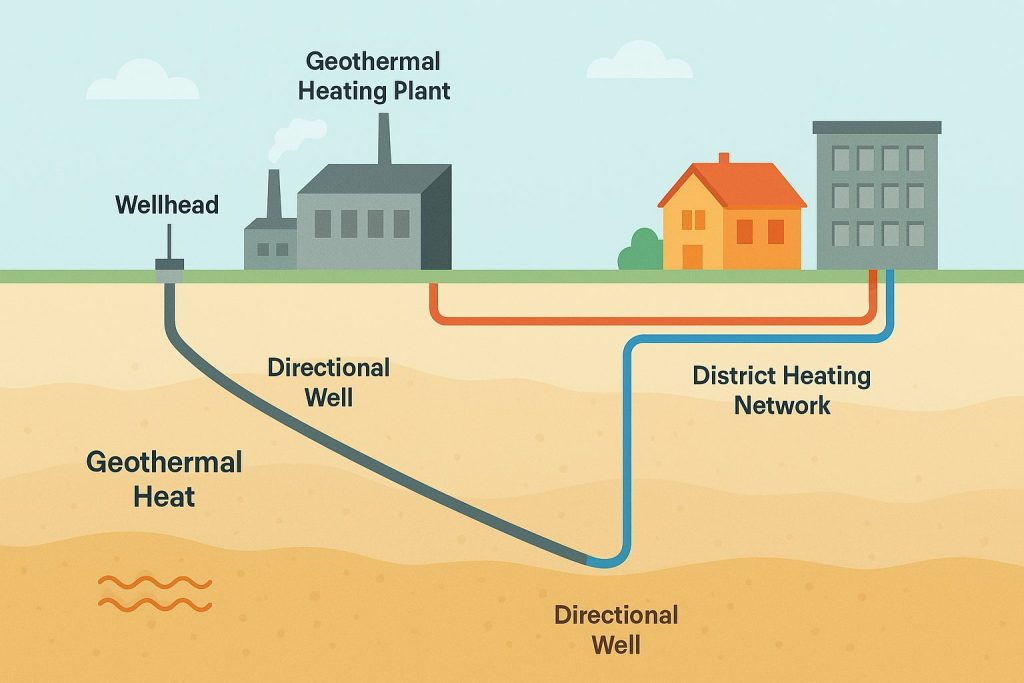A joint endeavour to work on large-scale and UK-based geothermal projects is underway. This follows the partnering of the British energy firm Star Energy and French infrastructure firm Veolia.
Reportedly, this joint work will include seismic and hydrogeological studies, directional drilling using growing technologies and advanced modelling and simulation.
The two companies endeavour to leverage geothermal energy to provide green electricity to hospitals, campuses, district heating schemes, industrial facilities, and commercial buildings alike.
What These Geothermal Projects Aim To Achieve
When we think of drilling directly into the Earth it is traditionally performed vertically such as for mining, oil, and environmental monitoring wells.
However, as part of a push toward more novel, eco-friendly and dynamic approaches to energy generation, directional drilling makes it possible to drill at a range of angles.
Directional Drilling To Further Geothermal Reach
Among the key upsides to non-vertical drilling is that geothermal resources not directly below the drilling site can be accessed at the correct angle. Directional drilling often offers further reach than vertical drilling too, making it perfect for geothermal energy projects.
You can think of directional drilling as like taking a route to underground reserves that would otherwise be hard or impossible to access if drilling from directly above.

Another comparison is the Channel Tunnel. While mostly horizontal, over the full course of the journey there are some vertical ebbs and flows, even if not really perceptible. In a sense, if you ever take the Chunnel to France, you’re taking a directional journey through the Earth.
The Channel Tunnel’s directional journey is not too dissimilar to non-vertical drilling. It descends vertically at an angle from Folkestone, then traverses mostly horizontal, before resurfacing in Calais. Directional drilling is quite similar to this type of trajectory.
All in all, with directional drilling, it’ll be possible to harness underground geothermal energy in the UK and add green electricity to the power grid. This is with the UK working toward 100% renewable electricity by 2030.
Hydrogeological Surveys And Seismic Studies
Hydrogeological and seismic studies, another aspect of this venture, are to look into underground water flow and geological flows for analyses relevant to geothermal energy.
How These Studies Help Harness More Geothermal Energy
When planning for near-term geothermal energy projects and improving the effectiveness of future projects, studying underground water flow can help researchers and companies actively involved in directional drilling for geothermal energy to better understand how to harness underground energy efficiently.
This type of research is essentially a means to help map out the underground terrain and conditions that directional drilling is working through. You might think of it as the study of subterranean rivers and lakes in an effort to determine where and how to harness geothermal energy.
Without the ability to see directly beneath the ground with our own eyes, naturally a range of tools, technologies, research and more are needed to bring everything together to harness geothermal power and these developments remain a work in progress.
The Role of Seismology
Seismology analyses seismic activity, and while not as dramatic or destructive in this part of the world as compared to say the western United States or Japan, there is still seismic activity all around the world.
UK-based earthquakes are generally measured as being in the magnitude 2 to 3 range (often difficult to perceive and only occasionally pop up on the news) and with each magnitude representing significant more strength than the prior, this means our earthquakes very rarely pose a threat to life.
This contrasts earthquakes in say the 6 to 8 magnitude range generally found around major fault lines, and would realistically only apply to magnitude 5 earthquakes under certain conditions (e.g. old structures very close to the epicentre).
Nonetheless, these seismic tremors are detectable with sensitive instruments and can inform research including for geothermal energy production.
Research And The Practical Coming Together For UK-French Partnership
While seismic surveys have conventionally been used to detect oil deposits, they now also have applications for geothermal energy as an eco-friendly and sustainable solution to powering Britain in the decades to come and beyond.
Hydrogeological studies focus on groundwater, exploring its physical and chemical makeup as well as how it moves and distributes.
Both studies work together since seismic activity affects groundwater levels whereas the hydrogeological state beneath the Earth in turn affects seismic waves.
Further Elements To UK-French Venture
Beyond that, the advanced simulations and modeling proposed will aim to further support to the partnership with advanced software capable of offering important simulations of geothermal reservoir behavior.
Lastly, by connecting to pre-existing heating networks and doing so with limited modifications, domestic geothermal energy can prove a low-carbon means of contributing toward the UK’s net-zero goals in a cost-effective manner.
So What Does This All Mean?
The type of holistic or multi-layered approach that Star Energy and Veolia plan to engage in, with directional drilling, seismic studies, advanced modelling and more, is the type of work that can lead to more effective efforts at harnessing energy to the benefit of households across the UK.
Each component can work together to accelerate geothermal energy, both in practice to meet the UK’s energy needs in the near-future and for developing the relevant technologies and knowledge needed to improve efficiency further in the years and decades to come.
The projects could also support decarbonisation, more dynamic energy supply chains and adapting to a more complex world. Not to mention the potential to encourage job growth and develop innovative approaches that inspire further developments elsewhere.